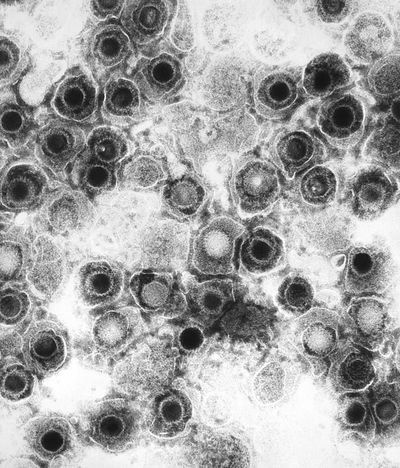Herpes Simplex Virus and Cancer: Difference between revisions
No edit summary |
No edit summary |
||
| Line 14: | Line 14: | ||
===Pathway and Evolution of HSV-1=== | ===Pathway and Evolution of HSV-1=== | ||
There are a plethora of protein to protein interactions that makeup the Herpes Simplex Virus pathway. One of the key characteristics in the replication and formation of this virus is the presence of capsids which hold the viral genome and which are generated by the interaction of two proteins, pUL19 and pUL6. This is important to cause lysis of the host cell while keeping the viral genome intact. A series of viral and cellular proteins are then combined to form a complex to create a proper environment for the virus to conduct primary envelopment and enter the inner nuclear membrane. It then exits the nuclear membrane and the capsids undergo secondary envelopment which causes the mature herpes virus to emerge and spread throughput the body as an active virus. | There are a plethora of protein to protein interactions that makeup the Herpes Simplex Virus pathway[http://ac.els-cdn.com/S1369527406000968/1-s2.0-S1369527406000968-main.pdf?_tid=6a4d2c48-d211-11e4-9afc-00000aacb362&acdnat=1427193476_b33c135b9ba26e5cf6c50436cb61488f: <sup>6</sup>] . One of the key characteristics in the replication and formation of this virus is the presence of capsids which hold the viral genome and which are generated by the interaction of two proteins, pUL19 and pUL6. This is important to cause lysis of the host cell while keeping the viral genome intact. A series of viral and cellular proteins are then combined to form a complex to create a proper environment for the virus to conduct primary envelopment and enter the inner nuclear membrane. It then exits the nuclear membrane and the capsids undergo secondary envelopment which causes the mature herpes virus to emerge and spread throughput the body as an active virus. | ||
===Replication of HSV-1=== | ===Replication of HSV-1=== | ||
Revision as of 11:09, 24 March 2015
Herpes Simplex Virus 1, also known as oral herpes, is responsible for causing sores in the mouth and lip region when infected1. It can be spread by oral secretions such as kissing and sharing objects that have contact with saliva1. It is estimated that up to 90% of people in the United States have had contact with HSV-1 by the age of 502. The virus has the ability to lay dormant for some time in the nerve cells until it gets triggered again, forming somewhat painful lesions1 that last two to three weeks4. There is no cure for Herpes, however there are treatments that allow for the lessening of these lesions and pain that are typical of patients with the HSV virus1.
Kaposi sarcoma is a type of cancer that can be formed in the lining of the mouth, nose, throat and lymph nodes 3 and it characterized by purple or red spots on the skin5. It also has the ability to damage internal organs and cause breathlessness, bleeding gums, and stomach pains5. This rare cancer was found to be caused by the HSV virus, which is fairly common in the population, yet most people do not develop the cancer5.Kaposi sarcoma was very common in men of Middle Eastern descent but has now been shown to be common in AIDS patients3 and others who have weakened immune systems5. There are various ways to try to reduce the cancer, such as the common technique of chemotherapy and radiotherapy but the cancer may never be eliminated5.
HSV-1
Understanding the molecular blueprint of HSV-1 is important in
Pathway and Evolution of HSV-1
There are a plethora of protein to protein interactions that makeup the Herpes Simplex Virus pathway6 . One of the key characteristics in the replication and formation of this virus is the presence of capsids which hold the viral genome and which are generated by the interaction of two proteins, pUL19 and pUL6. This is important to cause lysis of the host cell while keeping the viral genome intact. A series of viral and cellular proteins are then combined to form a complex to create a proper environment for the virus to conduct primary envelopment and enter the inner nuclear membrane. It then exits the nuclear membrane and the capsids undergo secondary envelopment which causes the mature herpes virus to emerge and spread throughput the body as an active virus.
Replication of HSV-1
Clinical Characterization of HSV-1
Overall paper length should be 3,000 words, with at least 3 figures with data.
Genetic Makeup of HSV-1
Karposi Sarcoma
Include some current research in each topic, with at least one figure showing data.
Genome of Kaposi Sarcoma
Proteins involved in formation
HSV-1 and Kaposi Sarcoma
Include some current research in each topic, with at least one figure showing data.
Pathway to Cancer by HSV-1
Further Reading
[Sample link] Ebola Hemorrhagic Fever—Centers for Disease Control and Prevention, Special Pathogens Branch
References
1. Johnson, Traci. "Herpes Simplex: Herpes Type 1 and 2." Genetial Herpes Health Center. Web MD. Web.
2. "Mouth Infections." Health Library. Johns Hopkins Medicine. Web.
3. Derrer, David. "HIV, AIDS, and Kaposi Sarcoma." HIV & AIDS Health Center. Web MD. Web.
5. "Kaposi's Sarcoma." NHS Choices. Web.
Edited by Alejandro Zuniga, a student of Nora Sullivan in BIOL168L (Microbiology) in The Keck Science Department of the Claremont Colleges Spring 2015.

